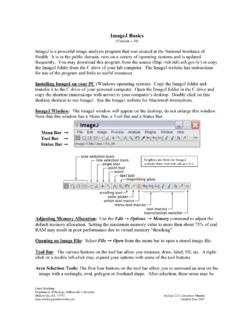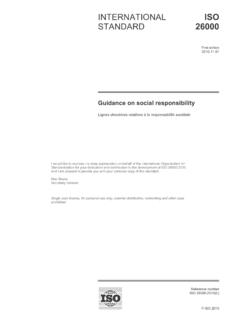Transcription of Your Child at 5 Years - Centers for Disease Control and ...
1 Child s Name Child s Age Today s Date How your Child plays, learns, speaks, and acts offers important clues about your Your Child at 5 Years Child s development. Developmental milestones are things most children can do by a certain age. Check the milestones your Child has reached by his or her 5th birthday. Take this with you and talk with your Child s doctor at every visit about the milestones your Child has reached and what to expect next. What Most Children Do at this Age: Act Early by Talking to Your Social/Emotional Child s Doctor if Your Child : q Wants to please friends q Wants to be like friends q Doesn t show a wide range of emotions q More likely to agree with rules q Shows extreme behavior (unusually fearful, aggressive, q Likes to sing, dance, and act shy or sad) q Is aware of gender q Unusually withdrawn and not active q Can tell what s real and what s make-believe q Is easily distracted, has trouble focusing on one activity for q Shows more independence (for example, may visit a next-door more than 5 minutesneighbor by himself [adult supervision is still needed])
2 Q Doesn t respond to people, or responds only superficially q Is sometimes demanding and sometimes very cooperative q Can t tell what s real and what s make-believe q Doesn t play a variety of games and activitiesLanguage/Communication q Can t give first and last name q Speaks very clearly q Doesn t use plurals or past tense properly q Tells a simple story using full sentences q Doesn t talk about daily activities or experiences q Uses future tense; for example, Grandma will be here. q Doesn t draw pictures q Says name and address q Can t brush teeth, wash and dry hands, or get undressed without help Cognitive (learning, thinking, problem-solving) q Loses skills he once had q Counts 10 or more things Tell your Child s doctor or nurse if you notice any of these q Can draw a person with at least 6 body parts signs of possible developmental delay for this age, and talk q Can print some letters or numbers with someone in your community who is familiar with services q Copies a triangle and other geometric shapes for young children in your area, such as your local public q Knows about things used every day, like money and food school.
3 For more information, go to or call 1-800-CDC- info . Movement/Physical Development q Stands on one foot for 10 seconds or longer q Hops; may be able to skip q Can do a somersault q Uses a fork and spoon and sometimes a table knife q Can use the toilet on her own q Swings and climbs Adapted from CARING FOR YOUR BABY AND YOUNG Child : BIRTH TO AGE 5, Fifth Edition, edited by Steven Shelov and Tanya Remer Altmann 1991, 1993, 1998, 2004, 2009 by the American Academy of Pediatrics and BRIGHT FUTURES: GUIDELINES FOR HEALTH SUPERVISION OF INFANTS, CHILDREN, AND ADOLESCENTS, Third Edition, edited by Joseph Hagan, Jr., Judith S. Shaw, and Paula M. Duncan, 2008, Elk Grove Village, IL: American Academy of Pediatrics. This milestone checklist is not a substitute for a standardized, validated developmental screening tool. Learn the Signs. Act Early. | 1-800-CDC- info Nombre del ni o Edad del ni o Fecha de hoy La manera en que su hijo juega, aprende, habla y act a nos ofrece pistas importantes sobre c mo se est desarrollando.
4 Los indicadores del desarrollo son las cosas que la mayor a de los ni os pueden hacer a una edad determinada. Marque los indicadores del desarrollo que puede ver en su hijo cuando cumple 5 a os de edad. En cada visita m dica de su hijo, lleve esta informaci n y hable con el pediatra sobre los indicadores que su hijo alcanz y cu les son los que deber a alcanzar a continuaci n. Su Hijo de 5 A os Qu Hacen los Ni os a Esta Edad? En las reas social y emocional q Quiere complacer a los amigos q Quiere parecerse a los amigos q Es posible que haga m s caso a las reglas q Le gusta cantar, bailar y actuar q Est consciente de la diferencia de los sexos q Puede distinguir la fantas a de la realidad q Es m s independiente (por ejemplo, puede ir solo a visitar a los vecinos de al lado) [para esto todav a necesita la supervisi n de un adulto] q A veces es muy exigente y a veces muy cooperador En las reas del habla y la comunicaci n q Habla con mucha claridad q Puede contar una historia sencilla usando oraciones completas q Puede usar el tiempo futuro.
5 Por ejemplo, la abuelita va a venir q Dice su nombre y direcci n En el rea cognitivia (aprendizaje, razonamiento, resoluci n de problemas) q Cuenta 10 o m s cosas q Puede dibujar una persona con al menos 6 partes del cuerpo q Puede escribir algunas letras o n meros q Puede copiar tri ngulos y otras figuras geom tricas q Conoce las cosas de uso diario como el dinero y la comida En las reas motora y de desarrollo f sico q Se para en un pie por 10 segundos o m s q Brinca y puede ser que d saltos de lado q Puede dar volteretas en el aire q Usa tenedor y cuchara y, a veces, cuchillo q Puede ir al ba o solo q Se columpia y trepa q No expresa una gran variedad de emociones q Tiene comportamientos extremos (demasiado miedo, agresi n, timidez o tristeza) q Es demasiado retra do y pasivo q Se distrae con facilidad, tiene problemas para concentrarse en una actividad por m s de 5 minutes q No le responde a las personas o lo hace solo superficialmente q No puede distinguir la fantas a de la realidad q No juega a una variedad de juegos y actividades q No puede decir su nombre y apellido q No usa correctamente los plurales y el tiempo pasado q No habla de sus actividades o experiencias diarias q No dibuja q No puede cepillarse los dientes, lavarse y secarse las manos o desvestirse sin ayuda q Pierde habilidades que hab a adquirido D gale al m dico o a la enfermera de su hijo si nota cualquiera de estos signos de posible retraso del desarrollo para su edad, y converse con alguien de su comunidad que conozca los servicios para ni os de su rea, como por ejemplo la escuela p blica m s cercana.
6 Para obtener m s informaci n, consulte o llame 1-800-CDC- info . Reaccione pronto y hable con eldoctor de su hijo se el ni o: Tomado de CARING FOR YOUR BABY AND YOUNG Child : BIRTH TO AGE 5, Quinta Edici n, editado por Steven Shelov y Tanya Remer Altmann 1991, 1993, 1998, 2004, 2009 por la Academia Americana de Pediatr a y BRIGHT FUTURES: GUIDELINES FOR HEALTH SUPERVISION OF INFANTS, CHILDREN, AND ADOLESCENTS, tercera edici n, editado por Joseph Hagan, Jr., Judith S. Shaw y Paula M. Duncan, 2008, Elk Grove Village, IL: Academia Americana de Pediatr a. Esta lista de verificaci n de indicadores del desarrollo no es un sustituto de una herramienta de evaluaci n del desarrollo estandarizada y validada. | 1-800-CDC- info Aprenda los signos. Reaccione pronto.














